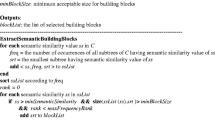Abstract
The stochastic schemata exploiter (SSE), which is one of the evolutionary algorithms based on schemata theory, was presented by Aizawa. The convergence speed of SSE is much faster than simple genetic algorithm. It sacrifices somewhat the global search performance.
This paper describes an improved algorithm of SSE, which is named as cross-generational elitist selection SSE (cSSE). In cSSE, the use of the cross-generational elitist selection enhances the diversity of the individuals in the population and therefore, the global search performance is improved.
In the numerical examples, cSSE is compared with genetic algorithm with minimum generation gap (MGG), Bayesian optimization algorithm (BOA), and SSE. The results show that cSSE has fast convergence and good global search performance.
Similar content being viewed by others
References
Aizawa A. Evolving SSE: A stochastic schemata explointer. In: Proceedings of 1st IEEE Conference on Evolutionary Computation, 1994: 525–529
Holland J H. Adaptation in Natural and Artificial Systems. The University of Michigan Press, 1975
Goldberg D E. Genetic Algorithms in Search, Optimization and Machine Learning. Addison Wesley, 1989
Baker J E. Reducing bias and inefficiency in the selection algorithm. In: Proceedings of the Second International Conference on Genetic Algorithms, 1987: 14–21
Whitly D. The genitor algorithm and selection pressure: Why rankbased allocation of reproductive traials in best. In: Shafer J D, ed. Proceedings of the 3rd International Conference on Genetic Algorithm. San Fransisco: Morgan Kaufmann Pub, 1989: 116–121
Satoh H, Ono I, Kobayashi S. Minimal generation gap model for gas considering both exploration and exploitation. In: Proceedings of the 4th International Conference on soft Computing (IIZUKA’96), 1996: 494–497
Ono I, Kobayashi S, Yoshida K. Global and multi-objective optimization for lens design by real-coded genetic algorithms. In: Proceedings of International Optical Design Conference, 1998, 3482: 110–121
Pelikan M, Goldberg D E, Cantu-Paz E. Boa: The bayesian optimiza tion algorithm. In: Banzhaf W, Daida J, Elben A E, et al, eds. Proceedings of the Genetic and Evolutionary Computation Conference 1999 (GECCO-1999, CA). San Fransisco: Morgan Kaufmann, 1999: 525–532
Eshelman L J. The CHC adaptive search algorithm: How to have safe search when engaging in nontraditional genetic recombination. In: Rawlins G J E, ed. Foundations of Genetic Algorithms 1991 (FOGA 1). San Fransisco: Morgan Kaufmann, 1991: 262–283
Whitley L D. Fundamental principles of deception in genetic search. In: Rawlins G J E, ed, Foundations of Genetic Algorithms 1991 (FOGA 1). San Fransisco: Morgan Kaufmann, 1991: 221–241
Watson R A, Pollack J B. Hierarchically-consistent test problems for genetic algorithms. In: Proceedings of 1999 Congress on Evolutionary Computation (CEC 99), 1999: 1406–1413
Author information
Authors and Affiliations
Rights and permissions
About this article
Cite this article
Maruyama, T., Kita, E. Evolutionary algorithm based on schemata theory. Front. Comput. Sci. China 3, 123–129 (2009). https://doi.org/10.1007/s11704-009-0001-y
Received:
Accepted:
Published:
Issue Date:
DOI: https://doi.org/10.1007/s11704-009-0001-y




